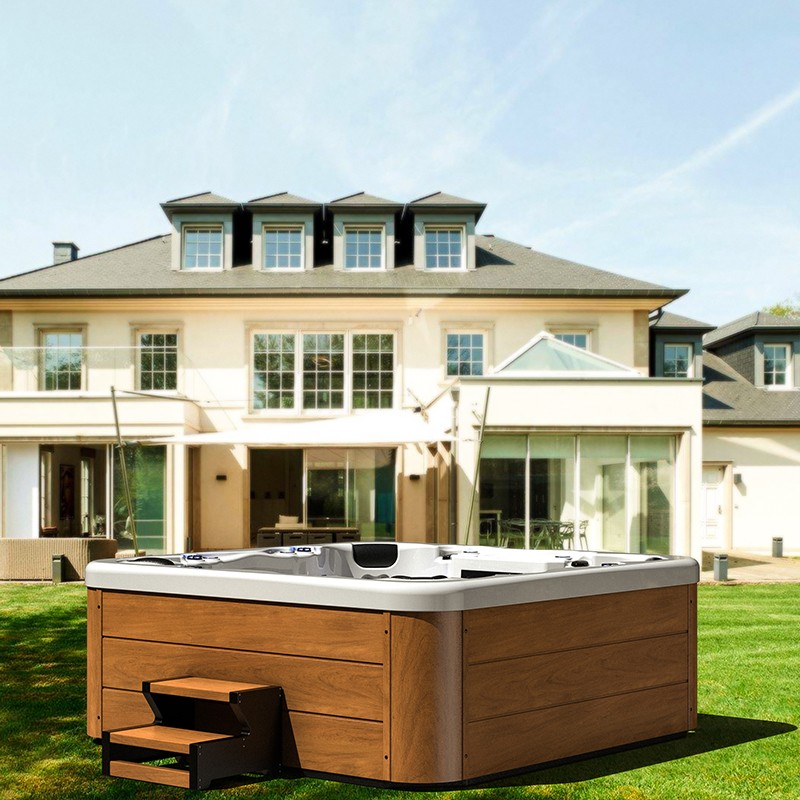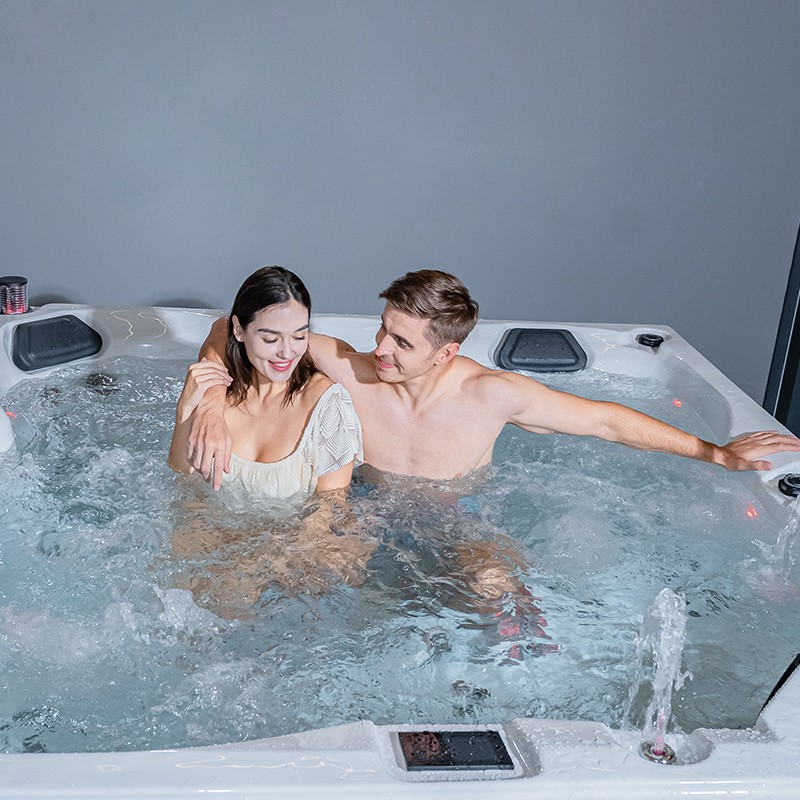
Why does skin peel after using a spa jacuzzi bathtub?
2025-11-17 15:30Many people find their skin becomes dry, tight, and even slightly peels after enjoying a relaxing spa jacuzzi bathtub. On the surface, this seems like just a result of "over-cleansing," but in reality, it involves multiple factors including a complex skin barrier response, the effects of hot water, chemical irritation, and soaking time.
Peeling is not a serious disease, but rather a natural repair response of the skin's stratum corneum after external stimulation. When we soak in the hot water of a spa jacuzzi bathtub for an extended period, some of the skin's natural oils are removed, and moisture is lost from the stratum corneum, weakening the skin's protective barrier and causing keratinocytes to loosen and shed. This physiological reaction is more pronounced in winter or in people with sensitive skin.
To understand the essence of this phenomenon, we need to analyze it from three aspects: skin structure, the hot water environment, and the chemical balance within the spa system.

What effect does the hot water in a spa jacuzzi bathtub have on the skin?
The main characteristics of a spa jacuzzi bathtub are high temperature and strong circulating water flow. Hot water can promote blood circulation, relieve muscle tension, and relax nerves, but for the skin, while it has benefits, it also carries potential risks.
First, hot water dissolves the skin's natural lipid barrier. This barrier, formed by a mixture of sebum secreted by sebaceous glands and sweat, has moisturizing, protective, and antibacterial functions. When the temperature is too high (above 40°C), this natural protective film is damaged, leading to rapid evaporation of skin moisture and loosening of the connections between keratinocytes, resulting in peeling.
Second, hot water stimulation accelerates skin cell turnover. In a short period, the skin's metabolic rate increases, and dead skin cells are rapidly shed, which visually appears as peeling. While this is part of skin renewal, frequent hot water stimulation prevents the skin from repairing itself in time, leading to persistent dryness and flaking.
Finally, the circulating water pressure of a spa jacuzzi bathtub may exacerbate this process. The strong water flow creates a frictional effect, slightly damaging the stratum corneum, making the skin more prone to dehydration, peeling, and even redness.

Do the chemicals in a spa jacuzzi bathtub cause skin peeling?
Many spa jacuzzi bathtubs require regular use of chemicals to maintain water cleanliness, such as chlorine, bromine, or ozone. These substances are effective at killing bacteria, algae, and fungi, but can also irritate the skin.
1. The Effects and Irritation of Chlorine
Chlorine is the most common disinfectant, but it has strong oxidizing properties. Chloride ions can damage the skin's lipid layer, leading to a thinner skin barrier and causing dryness, itching, or peeling. Especially in hot water environments, chlorine is more volatile, and the irritating fumes easily come into contact with the skin, exacerbating discomfort.
2. The Mild but Lasting Effects of Bromine
Bromine disinfectants are milder than chlorine, but bromine compounds easily remain on the skin surface, disrupting the pH balance of the stratum corneum. Long-term exposure can disrupt the skin's pH balance, reducing its natural defenses and potentially causing peeling or mild inflammation.
3. Ozone and Other Oxidizing Agents
Some high-end spa jacuzzi bathtubs use ozone disinfection systems. Although ozone residue is lower, its strong oxidizing properties can still damage skin cell membranes. Frequent use of this type of bathtub can cause repeated oxidation of the skin's barrier layer, leading to peeling of the stratum corneum.
Therefore, the selection and concentration control of water disinfectants are crucial for preventing peeling. Maintaining proper water balance not only extends the lifespan of the equipment but also reduces the occurrence of skin problems.
Does prolonged soaking in a spa jacuzzi bathtub weaken the skin barrier?
Yes, excessive soaking time is another core cause of peeling. After prolonged soaking, the stratum corneum absorbs water and swells, disrupting the lipid channels between corneocytes. Upon removal from the hot water, the moisture evaporates rapidly, leaving a dry, tight, and even cracked surface.
Especially in a spa jacuzzi bathtub, due to the constant water temperature and the comfortable massage effect of the bubbles, people often unconsciously prolong the soaking time. In this case, the skin's surface defense function temporarily decreases, easily leading to the following:
• Epidermal cell shedding, resulting in mild peeling;
• Redness or itching;
• Dryness lasting for several hours;
• Mild stinging may even occur in people with sensitive skin.
It is recommended to limit each bath session to 15–20 minutes, especially in high-temperature (above 40℃) spa environments.

Does the pH value of the spa jacuzzi bathtub affect skin health?
Absolutely. The skin's natural pH is approximately 4.5–5.5, slightly acidic. The ideal pH for a spa jacuzzi bathtub is typically between 7.2–7.8 to ensure effective disinfection and prevent equipment corrosion.
When the bath water is alkaline, it disrupts the skin's acidic protective layer, making the skin more prone to dryness and flaking. Lipids in the stratum corneum saponify in an alkaline environment, causing the keratinocyte structure to loosen. Prolonged exposure to this environment can cause rough skin, peeling, and even allergic reactions.
Maintaining the pH balance of the spa water is a crucial detail in preventing peeling. The pH value should be tested before and after each use, and fine-tuned using a dedicated pH adjuster if necessary.
Does the frequency of using a spa jacuzzi bathtub affect skin condition?
Yes. Even if a single bath won't cause immediate peeling, frequent use of a spa jacuzzi bathtub can lead to dryness and exfoliation as the skin's repair rate can't keep up with the rate of damage.
Skin needs time to restore its natural oils and barrier function. Prolonged daily soaks, even with perfect water quality and temperature, can cause peeling due to prolonged stress on the skin barrier.
Ideal frequency recommendations:
• General skin: 2–3 times per week;
• Dry or sensitive skin: 1–2 times per week;
• Each bath should not exceed 20 minutes.
Furthermore, moisturize immediately after bathing. Use a gentle, fragrance-free moisturizer to form a protective film on the skin's surface, preventing further moisture loss.
Is peeling skin after using a spa jacuzzi bathtub a sign of health or a warning?
Peeling is sometimes a natural part of skin renewal, but when it occurs frequently or is accompanied by dryness, itching, or redness, it indicates a damaged skin barrier. This is an early warning signal from the body. If the peeling is mild, it can be alleviated by reducing soaking time, lowering the water temperature, and increasing moisturizing. However, if redness, stinging, or significant inflammation occurs, you should discontinue use of the spa jacuzzi bathtub and use gentle, repairing skincare products. Consult a dermatologist if necessary.
How to prevent skin peeling after using a spa jacuzzi bathtub?
To enjoy a comfortable bath while avoiding skin problems, here are some practical tips:
✅ Control water temperature
The ideal spa jacuzzi bathtub temperature is between 37℃ and 39℃. Excessively high temperatures can accelerate sebum loss, increasing the risk of dry skin.
✅ Shorten soaking time
Soaking for 15–20 minutes at a time is recommended to avoid over-absorbing water.
✅ Maintain water balance
Regularly check the water's pH level and disinfectant concentration to ensure they are within safe ranges. Excessive chlorine or bromine can damage the skin.
✅ Use gentle cleansing and moisturizing products
After bathing, immediately rinse off any residual chemicals with water, then apply a moisturizing lotion containing ceramides, glycerin, or hyaluronic acid.
✅ Avoid overuse
Give your skin sufficient time to repair. If your skin is already dry, cracked, or peeling, discontinue use for a few days.
✅ Drink plenty of water
Hot baths can cause dehydration; adequate hydration helps maintain skin moisture.

Use spa jacuzzi bathtubs correctly to avoid peeling skin
The relaxing experience of a spa jacuzzi bathtub is irreplaceable, but hot water, disinfectants, pH imbalances, and excessive use can all lead to dry and peeling skin.
Fundamentally, peeling skin is a reversible defense mechanism. By correctly controlling the usage method, maintaining a suitable water temperature, good water quality, moderate frequency, and proper post-bath moisturizing care, you can maintain healthy and smooth skin while enjoying a spa massage.
Are LOVIA SPA Products Energy Efficient?
Yes, our spas are engineered with advanced filtration, insulation, and control systems that reduce energy consumption. Components like Balboa controls and LX pumps ensure maximum performance with minimal power use. Buyers seeking eco-friendly yet affordable options will find our models cost-efficient in the long run.
As a certified manufacturer, LOVIA SPA integrates high-quality materials with smart energy-saving design — offering low running costs, high reliability, and attractive factory pricing for wholesale and retail buyers worldwide.
